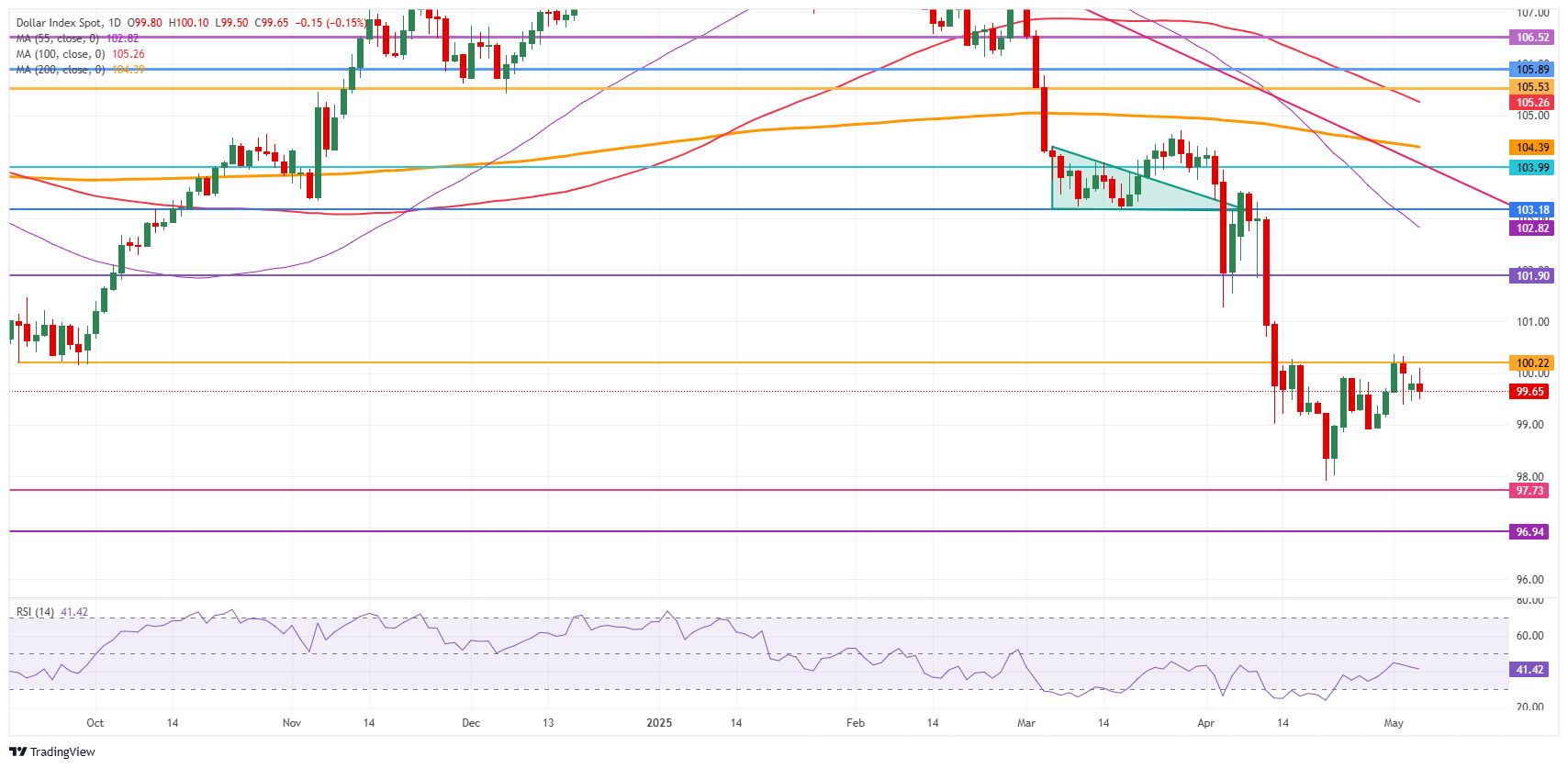
[ad_1]
- The edges of the US dollar index are slightly lower, although the daily range becomes more compact.
- Traders evaluate indirect risks from increasing the Taiwanese dollar on Monday to other currencies in the region.
- The US dollar index has been directed less than 100.00, and is still stuck in the waiting and vision range.
The US dollar index (DXY), which tracks the performance of the US dollar (USD) for six main currencies, the edges are decreasing with a very tightness in a very narrow range. Market participants evaluate the last sharp move in the Taiwan dollar (Taiwan), which were estimated by more than 5 % against Greenback on Monday before they decreased to some extent on Tuesday. The markets are trying to assess whether an indirect effect can occur, which affects larger Asian currencies like South Korea Won (KRW), Japanese yen (JPY) or Chinese Renminbi (CNH).
Meanwhile, on the geopolitical front, a group of major addresses made its way to the markets, where the upcoming German advisor, Fredchich Mirz lacked the majority in the German parliament vote to become the new chancellor. On the other side of the Atlantic Ocean, US Trade Minister Howard Lootnick linked the risks to the Trump administration to connect a preliminary trade deal soon by saying that the first deal needs to be with “the ten best economies”, Fox News said. In Europe, the war between Russia and Ukraine is heated with drone attacks on both sides, while Israel is preparing a ground attack with the aim of fully controlling the Gaza Strip.
Digest Market Mark: slow -up before Federal Reserve
- At 12:30 GMT, the trade balance of American goods and services is scheduled to deserve in March. Expectations are a wider deficit of $ 129 billion for a deficit of $ 122.7 billion from February.
- Arrows everywhere where several countries in Asia remain closed to spend a public vacation. European indexes rose about 0.50 % a day, while futures in the United States appear under pressure as Nasdak decreased near 1 %.
- The CME Fedwatch tool shows the opportunity to reduce the interest rate by the Federal Reserve at the May meeting by 3.2 % compared to 96.8 % of non -change. The June meeting is witnessing 31.8 % chance to reduce average.
- The US revenues are trading for 10 years about 4.31 %, as they erase the softening of the past weeks as traders have priced the chances of reducing interest rates.
Technical analysis of the US dollar index: inside the pressure
The US dollar index (DXY) faces some opposite winds after US Minister of Trade Lottennik increased from the Trump administration to obtain an initial business deal. Lutnick added that the initial deal should be with the top ten economies, in order to put an example. Despite many claims issued by US President Donald Trump and many cabinet members that deals are imminent, no real signature trade deals have been announced.
On the upper side, the first DXY resistance comes at 100.22, which supported DXY in September 2024, with a return to the 100.00 circle level as a bullish sign. Fixed recovery will be a return to 101.90, which was a pivotal level during December 2023 and again as a base to form the inverted head and shoulder (H&S) during the summer of 2024.
On the other hand, 97.73 support can be tested quickly on any major dumping address. Moreover, gentle technical support comes relatively at 96.94 before considering the lower levels of this new price range. This will be at 95.25 and 94.56, which means its lowest fresh levels that have not been seen since 2022.

US dollar index: daily chart
Common questions between the United States of China for war
In general, the trade war is an economic conflict between the two countries or more due to severe protectionism at one party. It involves the creation of commercial barriers, such as customs tariffs, which lead to anti -import barriers, and to import costs, and thus the cost of living.
The economic conflict between the United States (the United States) and China began in early 2018, when President Donald Trump laid commercial barriers on China, claiming unfair commercial practices and theft of intellectual property from the Asian giant. China has taken retaliatory measures and imposed a tariff on multiple American goods, such as cars and soybeans. Tensions escalated until the two countries signed the commercial deal for the first stage of the United States of China in January 2020. The agreement requires structural reforms and other changes on the economic and commercial system in China and demonstrated by restoring stability and confidence between the two countries. However, the Koronavus virus’s pandemic took the focus from the conflict. However, it should be noted that President Joe Biden, who took office after Trump, maintained the customs tariff in his place and added some additional fees.
Donald Trump’s return to the White House as an American president ignited 47 new waves of tensions between the two countries. During the 2024 election campaign, Trump pledged to impose 60 % of the customs tariff on China once he returns to his position, which he did on January 20, 2025. With the emergence of Trump, the American trade war and China aim to resume the place where it was left, with policies for corrections that affect global economic records in nutrition in nutrition.
